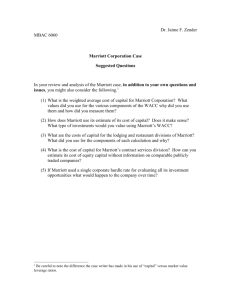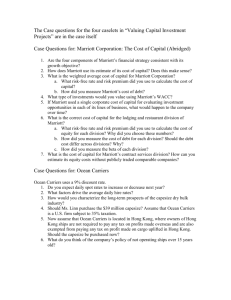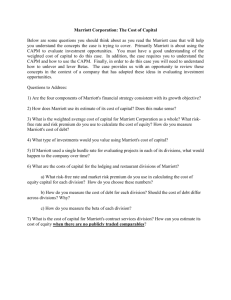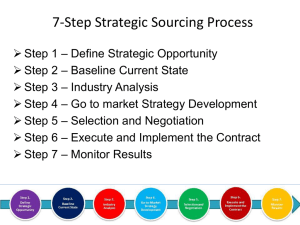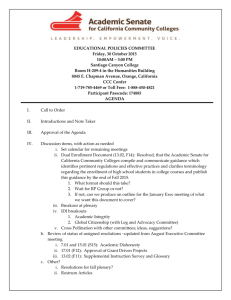Video Case 4.1
advertisement
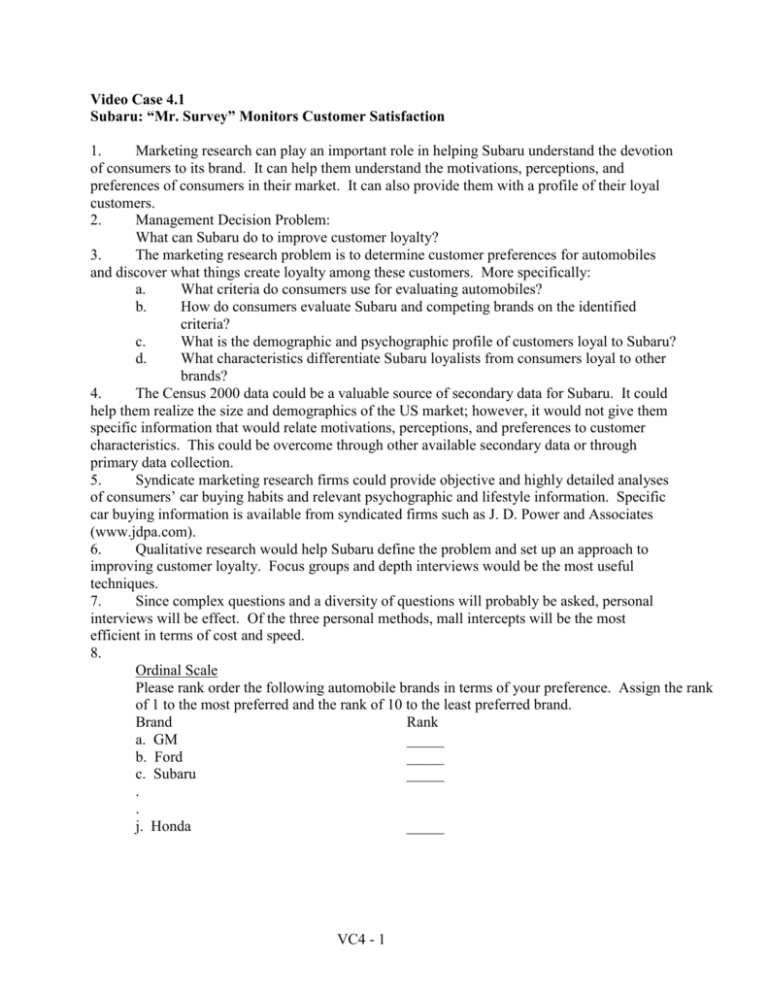
Video Case 4.1 Subaru: “Mr. Survey” Monitors Customer Satisfaction 1. Marketing research can play an important role in helping Subaru understand the devotion of consumers to its brand. It can help them understand the motivations, perceptions, and preferences of consumers in their market. It can also provide them with a profile of their loyal customers. 2. Management Decision Problem: What can Subaru do to improve customer loyalty? 3. The marketing research problem is to determine customer preferences for automobiles and discover what things create loyalty among these customers. More specifically: a. What criteria do consumers use for evaluating automobiles? b. How do consumers evaluate Subaru and competing brands on the identified criteria? c. What is the demographic and psychographic profile of customers loyal to Subaru? d. What characteristics differentiate Subaru loyalists from consumers loyal to other brands? 4. The Census 2000 data could be a valuable source of secondary data for Subaru. It could help them realize the size and demographics of the US market; however, it would not give them specific information that would relate motivations, perceptions, and preferences to customer characteristics. This could be overcome through other available secondary data or through primary data collection. 5. Syndicate marketing research firms could provide objective and highly detailed analyses of consumers’ car buying habits and relevant psychographic and lifestyle information. Specific car buying information is available from syndicated firms such as J. D. Power and Associates (www.jdpa.com). 6. Qualitative research would help Subaru define the problem and set up an approach to improving customer loyalty. Focus groups and depth interviews would be the most useful techniques. 7. Since complex questions and a diversity of questions will probably be asked, personal interviews will be effect. Of the three personal methods, mall intercepts will be the most efficient in terms of cost and speed. 8. Ordinal Scale Please rank order the following automobile brands in terms of your preference. Assign the rank of 1 to the most preferred and the rank of 10 to the least preferred brand. Brand Rank a. GM _____ b. Ford _____ c. Subaru _____ . . j. Honda _____ VC4 - 1 Interval Scale Please rate the following automobile brands in terms of your preference using the seven-point scale, where 1 = no preference, and 7 = strong preference. No Preference Strong Preference a. GM 1 2 3 4 5 6 7 b. Ford 1 2 3 4 5 6 7 c. Subaru 1 2 3 4 5 6 7 . . j. Honda 1 2 3 4 5 6 7 Ratio Scale How many dollars did you spend in the last ten years on the following automobile brands? Brand Dollars Spent a. GM _____ b. Ford _____ c. Subaru _____ . . j. Honda _____ AUTOMOBILE QUESTIONAIRE PART A Q1: Are you familiar with Subaru’s automobiles? a. Yes _____ b. No _____ If you answered No to this question, please do not answer any additional questions. Thank you for your time. Q2: Have you ever purchased a Subaru? a. Yes _____ b. No _____ (If No, skip to Question 5) Q3. Which brand of Subaru did you purchase? Please check all that apply. a. Outback _____ b. Forester _____ c. Legacy _____ d. Impreza _____ e. Baja _____ Q4: Are you likely to buy a Subaru brand again when you are in the market for an automobile? a. Yes _____ b. No _____ VC4 - 2 Q5. a. b. c. d. e. f. g. Q6. a. b. c. d. e. f. g. Q7. a. b. c. d. e. f. g. Q8. a. b. c. d. e. f. g. Q9. a. b. c. How important are the following factors in your decision to purchase an automobile brand? Not Important Neutral Very Important Reliability 1 2 3 4 5 Performance 1 2 3 4 5 Gas Mileage 1 2 3 4 5 Repair & Maintenance 1 2 3 4 5 Price 1 2 3 4 5 Image 1 2 3 4 5 Features 1 2 3 4 5 Please evaluate Subaru brands on the following: Very Poor Neutral Reliability 1 2 3 4 Performance 1 2 3 4 Gas Mileage 1 2 3 4 Repair & Maintenance 1 2 3 4 Price 1 2 3 4 Image 1 2 3 4 Features 1 2 3 4 Very Good 5 5 5 5 5 5 5 Please evaluate Toyota brands on the following: Very Poor Neutral Reliability 1 2 3 4 Performance 1 2 3 4 Gas Mileage 1 2 3 4 Repair & Maintenance 1 2 3 4 Price 1 2 3 4 Image 1 2 3 4 Features 1 2 3 4 Very Good 5 5 5 5 5 5 5 Please evaluate Honda brands on the following: Very Poor Neutral Reliability 1 2 3 4 Performance 1 2 3 4 Gas Mileage 1 2 3 4 Repair & Maintenance 1 2 3 4 Price 1 2 3 4 Image 1 2 3 4 Features 1 2 3 4 Very Good 5 5 5 5 5 5 5 Please evaluate Nissan brands on the following: Very Poor Neutral Reliability 1 2 3 4 Performance 1 2 3 4 Gas Mileage 1 2 3 4 Very Good 5 5 5 VC4 - 3 d. e. f. g. Repair & Maintenance Price Image Features 1 1 1 1 2 2 2 2 3 3 3 3 4 4 4 4 10) What is your gender? _____Male _____Female 11) What age group are you in? _____18-24 _____25-29 _____30-34 _____35-44 _____45-64 _____65 and over 12) What category of income do you fit into? _____0-$20,000 _____$20,001-$35,000 _____$35,001-$50,000 _____$50,001-$100,000 _____$100,001 and above 13) What is your marital status? _____Married _____Single 14) If you were ever married, how many children do you have? _____None _____One _____Two _____Three _____Four or more 5 5 5 5 PART II Thank you for your time. Your assistance will help us in better meeting your automobile needs. ________________________________________________________________ 9. Target population: US population age 16 and older that own a car Sampling frame: People at malls across the US Sampling unit: Individual consumers at malls Sampling technique: Quota sampling Sample size: 1000 Execution: Select specific shopping malls based on the judgment of the researcher. Set quotas by age and gender. Use quota sampling to select mall patrons and interview them. VC4 - 4 10. a. The simple correlation coefficient can be estimated between the willingness to purchase an automobile brand and each of the seven independent variables. One could also run seven bivariate regressions. In these regressions, the dependent variable will be the willingness to purchase an automobile brand and each of the seven independent variables will serve as the predictor variable. These analyses will be conducted across the four automobile brands. b. A multiple regression should be estimated. The dependent variable will be the willingness to purchase an automobile brand and the seven independent variables should be considered simultaneously in the regression. This analysis will be conducted across the four automobile brands. c. A paired samples t test should be conducted with Subaru’s ratings on reliability and image as the two variables. d. A paired samples t test should be conducted with the Toyota’s rating on reliability and Subaru’s ratings on reliability serving as the two variables. e. Seven independent samples t tests should be conducted with each independent variable serving as the test variable. The grouping variable will be those who have purchased and those who have not purchased a Subaru automobile. f. An independent samples t test should be conducted with willingness to purchase Subaru brands as the test variable and gender as the grouping variable. g. A one-way ANOVA should be conducted with the four groups as the factor and willingness to purchase Subaru brands as the dependent variable. h. A cross-tabulation should be conducted with the four age groups as the independent variable and willingness to purchase Toyota brands as the dependent variable. i. A one-way ANOVA should be conducted with the three marital status groups as the factor and willingness to purchase Subaru brands as the dependent variable. j. A cross-tabulation should be conducted with the three marital status groups as the independent variable and willingness to purchase Toyota brands as the dependent variable. 11. Subaru needs to address differences in the lifestyle/pastime (autobahn) and popular sports (soccer) in their marketing research. They also need to consider other socio-cultural factors such as environmental friendliness and research methodology in Germany. In addition, economical/infra-structural factors, marketing environment, government environment, legal environment, and information and technological environment should be considered as well. 12. With regard to the general public, ethical concerns revolve primarily around the methods of generating and reporting research results. It is the joint responsibility of the researcher and the client to ensure that the research findings are being disseminated accurately. In particular, care VC4 - 5 should be taken by both the market researcher and the client to avoid incomplete reporting, misleading reporting, and biased research. It is the marketing researcher’s responsibility to protect the respondents from unethical research practices. Two issues deserve special attention: conducting a survey as a guise to sell products, and the invasion of the privacy of the respondent. Given the complexity involved, it is not surprising that the ethical issues surrounding the researcher-client relationship are somewhat numerous. Areas that deserve special attention from an ethical standpoint are: abuse of position arising from specialized knowledge, unnecessary research, an unqualified researcher, disclosure of identity, treating data as nonconfidential, and misleading presentation of data. The researcher (or the research firm) has the right to be treated ethically as well. Ethical treatment by clients involves several issues: improper solicitation of proposals, disclosure of proprietary techniques, and misrepresentation of findings. VC4 - 6 Video Case 4.2 Marriott: Marketing Research Leads to Expanded Offerings 1. Marketing research has played a crucial role in helping Marriott segment the market and develop its line of hotels. Marketing research is needed if Marriott is to keep track of changing consumer and business customer needs, identify new opportunities in the hotel market, further develop and differentiate its various brands, and develop strong equity. 2. The management decision problem is: “To what degree and in what way should Marriott further penetrate the non-business travelers segment in the United States?” This statement is action-oriented and asks what the decision maker should do in regards to Marriott presence in the target market. 3. The marketing research problem is to determine non-business travelers’ preferences for hotels and to assess their evaluations of Marriott and its competitors. Specifically, 1) What attitudes and perceptions non-business travelers have about hotels in the United States? 2) What criteria do non-business travelers use in selecting a hotel? 3) How do non-business travelers evaluate the existing Marriott and competitors’ hotels in the target area? 4) What is the demographic and psychographic profile of Marriott non-business customers and does it differ from the profile of non-business travelers who patronize competing hotels? 4. An appropriate research design would be to begin with exploratory research followed by descriptive research. The objective of exploratory research is to identify the relevant factors that business and non-business travelers use in evaluating hotels. Exploratory research should involve the analysis of secondary data and qualitative research in the form of focus groups. The objective of descriptive research would be to quantitatively measure the preferences for Marriott and competing hotels. Cross-sectional descriptive surveys are recommended for this purpose. 5. In order to obtain the required information, three types of online searches can be utilized. First, key words should be entered in standard search engines like www.google.com and www.yahoo.com. The keywords should be descriptive of the type of information and attempt to restrict the number of responses. Some of the keywords that could be used are: “hotels and market share”, “Marriott and market share” and “Hilton and market share,” etc. The second type of search that can be used is a database search. Through the library Web site, students can search for articles in magazines, papers and periodicals like New York Times and News Week concerning market share in the hotel industry. In addition, Lexis-Nexis Academic Universe business and industry news database can be used to search for market share statistics. Finally, the Web sites of major hotels should be visited looking for press releases that may contain the information needed. 6. Marriott has a marketing research department within the organization. They collect a lot of secondary data on an ongoing basis and in response to specific marketing problems and opportunities. These data can provide valuable information such as: the number of non-business travelers staying at each of the Marriott’s hotels over time, the relative occupancy by nonbusiness versus business travelers over time by specific Marriott brands, average length of stay by non-business travelers, etc. These data can provide an understanding of the non-business traveler segment and how this segment selects a hotel. VC4 - 7 7. Syndicated surveys would be useful. Specifically, hotel habits and practices as a part of Psychographic and Lifestyle surveys should provide relevant information. Nielsen Television Index (NTI) provides information on who was watching which program, so that audience size and demographic characteristics can be calculated. In addition, syndicated industry services can provide valuable information on the hotel industry. 8. It is the role of qualitative research to provide Marriott with relevant information that will help better define the problem of further penetrating the non-business travelers segment. It can aid the development of an approach to the problem via the generation of better hypothesis and the inclusion of variables, which are not intuitive. It should be noted that qualitative research is an unstructured and non-statistical technique and its results would be misused if Marriott uses them to draw generalizations about the greater population or regard them as conclusive. Focus groups could provide impressions of new hotel products, pricing and ideas about older brands. All this is valuable information for a company thinking about expanding further in a market. Besides, this information would lead to better marketing research further down the line by defining the problem more precisely, generating alternative courses of action, developing better approaches to the problem, designing questionnaires, and interpreting statistical results. Depth interviews could play a role in the Marriott case study even though their need is debatable because the insight and understanding sought can easily come from focus groups. Depth interviews would be used to discuss confidential, sensitive and embarrassing topics such as personal finances, spending habits, and eating habits. Deeper probing for the moods and emotions during a hotel stay would be obtained this way. Projective techniques are complicated, subjective to a certain degree and have nothing more to offer in this case. Information of the Marriott problem can be obtained easily from the direct qualitative method, thus making the use of projective techniques unnecessary. 9. Mall-intercept personal interviews would be appropriate because brochures of the new hotel package may have to be shown and the concept explained to the respondents in order to obtain meaningful responses. In addition, there will be good sample control as the profile of the mall shoppers closely matches the profile of the non-business travelers. This method offers flexibility and the quantity of data that can be collected, and the response rates are good. The control of the field force is not a problem as the interviews are conducted in a central location. Since the issue is not sensitive, social desirability bias and the need for perceived anonymity are not salient. The speed and cost of data collection are reasonable. 10. Likert scale: Strongly Disagree Neutral Agree Strongly Disagree Agree I prefer Marriott hotel 1 2 3 4 5 Semantic differential scale: My preference for Marriott hotel is: Strong -- -- -- -- -- -- -Weak Stapel scale: My preference for Marriott hotel is: +5 +4 +3 VC4 - 8 +2 +1 Preference -1 -2 -3 -4 -5 11. See the Marriott questionnaire in the following. HOTEL QUESTIONNAIRE PART A Q1. How often do you stay in a hotel? a. Less than once a year ____ b. Once a year ____ c. 2 or 3 times a year ____ d. Four or more times a year ____ Q2. Which meals do you typically eat in a hotel when staying there? Please check all that apply. a. Breakfast ____ b. Lunch ____ c. Dinner ____ d. Other (Please specify) ____ e. Do not eat in a hotel ____ Q3. Please rate the importance of the following factors in your selection of a hotel? Not at all Very Important Important a. Quality 1 2 3 4 5 6 7 b. Amenities 1 2 3 4 5 6 7 c. Service 1 2 3 4 5 6 7 d. Price 1 2 3 4 5 6 7 e. Comfort 1 2 3 4 5 6 7 f. Convenience of location 1 2 3 4 5 6 7 Q4. Please rate your preference for the following hotels. Not at all Preferred a. Quality 1 2 b. Amenities 1 2 c. Service 1 2 VC4 - 9 3 3 3 4 4 4 5 5 5 Very Much Preferred 6 7 67 6 7 d. Price e. Comfort f. Convenience of location 1 1 1 2 2 2 3 3 3 4 4 4 5 5 5 6 6 6 7 7 7 Q5. Please rate the following hotels in terms of Quality. Poor a. Holiday Inn 1 2 b. Marriott 1 2 c. Sheraton 1 2 d. Doubletree 1 2 e. Wyndham 1 2 f. Best Western 1 2 3 3 3 3 3 3 4 4 4 4 4 4 5 5 5 5 5 5 Excellent 6 7 6 7 6 7 6 7 6 7 6 7 Q6. Please rate the following hotels in terms of Amenities. Poor a. Holiday Inn 1 2 b. Marriott 1 2 c. Sheraton 1 2 d. Doubletree 1 2 e. Wyndham 1 2 f. Best Western 1 2 3 3 3 3 3 3 4 4 4 4 4 4 5 5 5 5 5 5 Excellent 6 7 6 7 6 7 6 7 6 7 6 7 Q7. Please rate the following hotels in terms of Service. Poor a. Holiday Inn 1 2 b. Marriott 1 2 c. Sheraton 1 2 d. Doubletree 1 2 e. Wyndham 1 2 f. Best Western 1 2 3 3 3 3 3 3 4 4 4 4 4 4 5 5 5 5 5 5 Excellent 6 7 6 7 6 7 6 7 6 7 6 7 Q8. Please rate the following hotels in terms of a value Price. Poor a. Holiday Inn 1 2 3 b. Marriott 1 2 3 c. Sheraton 1 2 3 d. Doubletree 1 2 3 e. Wyndham 1 2 3 f. Best Western 1 2 3 4 4 4 4 4 4 5 5 5 5 5 5 Excellent 6 7 6 7 6 7 6 7 6 7 6 7 5 5 5 Excellent 6 7 6 7 6 7 Q9. Please rate the following hotels in terms of Comfort. Poor a. Holiday Inn 1 2 b. Marriott 1 2 c. Sheraton 1 2 VC4 - 10 3 3 3 4 4 4 d. Doubletree e. Wyndham f. Best Western 1 1 1 2 2 2 3 3 3 4 4 4 5 5 5 Q10. Please rate the following hotels in terms of Convenience of Location. Poor a. Holiday Inn 1 2 3 4 5 b. Marriott 1 2 3 4 5 c. Sheraton 1 2 3 4 5 d. Doubletree 1 2 3 4 5 e. Wyndham 1 2 3 4 5 f. Best Western 1 2 3 4 5 PART B In this part, we would like to ask you some questions for classification purposes. Q11. Your Gender: 1. Male 2. Female _____ _____ Q12. Marital Status: 1. Married _____ 2. Never Married _____ 3. Divorced/Separated/Widowed _____ Q13. Family Size: 1. One 2. Two 3. Three 4. Four 5. Five or more _____ _____ _____ _____ _____ Q14. Your Age: 1. 18-24 2. 25-40 3. 41-60 4. 60+ _____ _____ _____ _____ Q15. Your Formal Education 1. Less than High School 2. High School Graduate 3. Some College 4. College Graduate _____ _____ _____ _____ Q16. What is Your Occupation? ____________________ VC4 - 11 6 6 6 7 7 7 Excellent 6 7 6 7 6 7 6 7 6 7 6 7 Q17. What is the approximate combined annual income of your household before taxes? 1. 2. 3. 4. 5. 6. $30,000 or less $30,001 to 50,000 $50,001 to 75,000 $75,001 to 100,000 $100,001 to 150,000 $150,001 and over _____ _____ _____ _____ _____ _____ Thank you for your participation. ____________________________________________________________________________ 12. Convenience sampling could be used for mall-intercept interviews Target population: Mall shoppers in the United States in the current year Sampling frame: Malls in the United States Sampling unit: Malls and then shoppers Sampling technique: Mall-intercept interviews (Convenience sampling) Sample size: 500 Execution: Interview shoppers in the selected malls by intercepting them in key locations in the mall. Note that imposing quotas is not necessary since the profile of the mall shoppers closely matches that of target population. 13. This sample size of 500 was selected based on qualitative considerations, such as the importance of the decision, nature of the research, statistical analyses that would be required, resource constraint, and the sample sizes used in similar studies Marriott had conducted in the past. 14. Training is needed in the following areas: * Making the initial contact - The initial contact is important to gain the confidentiality and trust of respondents. Practice in approaching people should be a part of the training, including an opening line. * Asking Questions - As always, field workers must ask the questions exactly as worded in order to prevent interviewer bias. Field workers should be instructed to abide by the guidelines listed in the text. * Probing - When respondents do not sufficiently answer the question, it is necessary to motivate them to respond or clarify their answers. Training should cover different techniques of probing so that field workers are comfortable with at least one technique. * Recording answers - Field workers should be familiar with the survey form and know how to mark responses on the form. The entire form should be reviewed in detail. Recording answers to unstructured questions should be reviewed as well. The guidelines listed in the text should be followed. * Terminating the interview - Field workers should be instructed to close each interview in a polite and gracious manner after all the information has been obtained. Supervision of field workers will be important. Quality control and editing is needed regardless of the mode of data collection. Sampling control VC4 - 12 should not be a significant problem since the interviews are taking place in a mall, yet supervisors should keep daily records on the number of contacts made, refusals, and completed interviews. Control over interviewer cheating should not be a problem since all the interviews will take place in a mall. Finally, central office controls are also needed, such as checking quota variables, demographic characteristics, and answers to key variables. 15. a. Correlation between preference rating and each of six independent variables Dependent variable: preference rating Independent variable: product quality, price, service, facilities, staffing, or uniqueness. A positive relationship is expected. b. Multiple regression between preference rating and all six independent variables. dependent variable: preference rating Six independent variables: product quality, price, service, facilities, staffing, and uniqueness. c. Hypothesis testing using t-test for paired samples (paired variables: product quality and price). d. Hypothesis testing using t-test for two independent samples (patrons and nonpatrons). e. ANOVA Dependent variable: Preference for Marriott Independent variable: Product usage (heavy, medium, and light users). f. Since 13 per cent represents a large number of cases, throwing out these respondents (i.e., casewise deletion) is not an attractive option. Pairwise deletion and substitution of the missing values with the variable mean should be tried. g. Each hotel will coded as a 1 of the respondent had stayed there and 0 otherwise. 16. Pie Charts can be used to present percentage estimates. Histograms and bar charts, since frequency counts, will be obtained for most of interval scaled variables. Line charts will not be used since the data are cross-sectional and pertain to a single point in time. 17. The difference in the environments of countries, cultural units, or foreign markets should be considered while conducting international marketing research. These differences may arise in the marketing environment, government environment, legal environment, economic environment, structural environment, informational and technological environment, and sociocultural environment. 18. With regard to the general public, ethical concerns revolve primarily around the methods of generating and reporting research results. It is the joint responsibility of the researcher and the client to ensure that the research findings are being disseminated accurately. Incomplete reporting, misleading reporting, and biased research should not take place. It is to the marketing researcher’s advantage to protect the respondents from unethical research practices. Two of these deserve special attention: conducting a survey as a guise to sell products, and the invasion of the respondent’s privacy. The ethical issues surrounding the researcher-client relationship are: abuse of position arising from specialized knowledge; unnecessary research; an unqualified researcher; disclosure of identity; treating data as nonconfidential; and misleading presentation of data. VC4 - 13 The researcher (or the research firm) has the right to be treated ethically as well. Ethical treatment by clients involves several issues: improper solicitation of proposals, disclosure of proprietary techniques, and misrepresentation of findings. VC4 - 14

